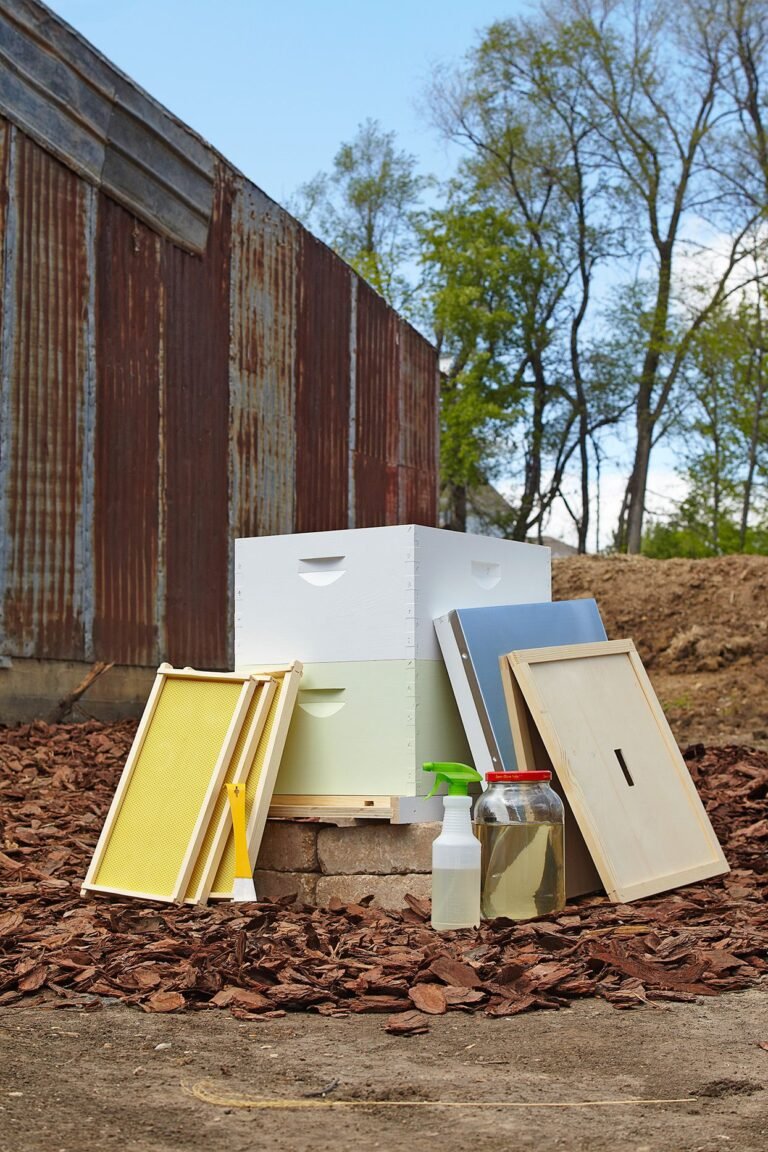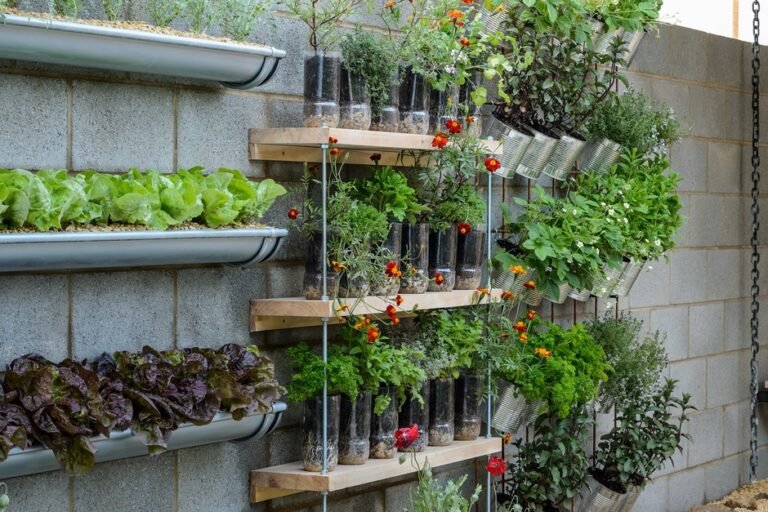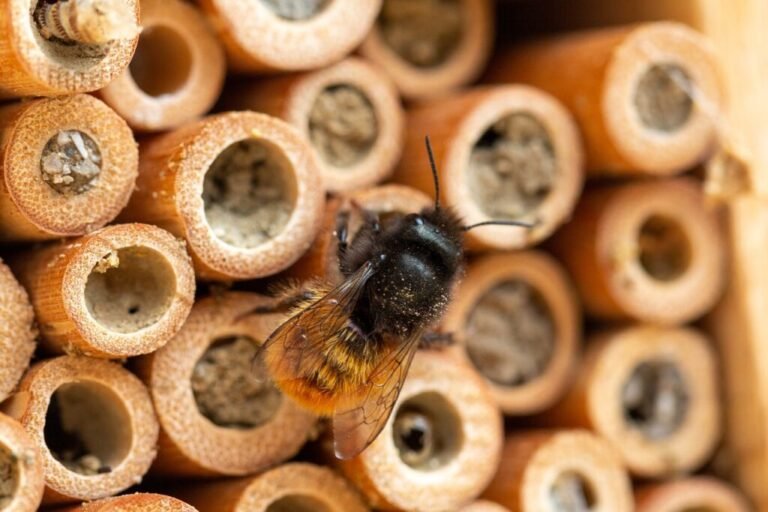Bee hotels are a buzz-worthy project for garden lovers and nature enthusiasts alike. These structures provide safe havens for solitary bees, vital pollinators in our ecosystems.
Building a DIY bee hotel invites these helpful insects to your garden, ensuring plants thrive and supporting biodiversity. Crafting a bee hotel can be a delightful weekend project. It doesn’t require expert woodworking skills or expensive materials. Simple items, often found around the home, can create a cozy retreat for bees.
The right materials make all the difference. They ensure the hotel is inviting and safe for its winged guests. This guide will help you select the best materials to construct a sturdy and sustainable bee hotel. It’s not just about piling up bamboo sticks or drilling holes in wood. There are dos and don’ts to guarantee your hotel is a five-star accommodation for bees. With careful consideration and a bit of creativity, your DIY bee hotel will become a buzzing hub of activity, contributing to the health of your local environment.
Introduction To Diy Bee Hotels
DIY bee hotels are simple structures you can create to support local bee populations. They provide safe nesting sites for solitary bees, crucial for pollination and biodiversity.
Importance Of Bees In Ecosystems
Bees play a vital role in pollinating plants. This includes many fruits, vegetables, and nuts. Without bees, ecosystems and food supplies would face major challenges.
- Essential for pollination
- Maintain biodiversity
- Support food production
Benefits Of Having A Bee Hotel
Installing a bee hotel in your garden has multiple perks:
- Boosts local bee populations
- Enhances plant growth
- Encourages biodiversity

Choosing The Right Location
Bees need a safe and suitable home to thrive. The location of your DIY bee hotel plays a critical role in its success. Here, we’ll explore the best spots for your bee haven.
Sun Exposure And Shade
Bee hotels require warmth from the morning sun. Yet, they also need protection from the intense afternoon heat. Consider east-facing walls or fences. These spots catch the morning light but avoid the harsher afternoon rays. Ensure the location is free from obstructions that could block the sun.
- Look for areas that get morning sunlight.
- Avoid places that are hot and sunny all day.
- Ensure no shadows fall on the hotel during the morning.
Protection From Predators And Pesticides
Keep your bee hotel safe from threats. Place it at least a meter above ground. This height keeps the bees beyond the reach of many predators. Avoid areas near pesticide use. Pesticides can harm bees.
| Predator | Prevention Tip |
|---|---|
| Rodents | Install above ground level |
| Birds | Use wire mesh for protection |
| Pesticides | Select a chemical-free zone |
Choose a spot away from foot traffic and pets. Peace is key for a thriving bee community.
Basic Design Principles
Building a DIY Bee Hotel requires understanding basic design principles. These principles ensure a safe, welcoming environment for different bee species. Let’s explore how size, shape, and compartment creation play crucial roles.
Size And Shape Considerations
The right size and shape are key for a successful bee hotel. A simple, rectangular design works well. It should be at least 8 inches deep. This depth provides enough space for various bee species. For height and width, aim for 12 inches by 12 inches. This size supports multiple compartments without being too bulky.
Creating Compartments For Different Bee Species
Different bees need different spaces. To cater to this, create compartments. Use bamboo sticks, drilled wood blocks, and straw. These materials offer varied hole sizes and depths. Here’s a quick guide:
- Bamboo sticks – good for small bees. Cut them to fit the depth of your hotel.
- Drilled wood blocks – offer sturdy holes. Drill holes 3/32 to 5/16 inches wide, at least 3-6 inches deep.
- Straw – perfect for very small bees. Ensure the ends are open and accessible.
Arrange these materials in separate compartments within your bee hotel. This diversity encourages more bee species to visit and stay.
Natural Materials For Construction
Natural materials offer the best habitat for bees. Creating a DIY bee hotel becomes a fun and impactful project. Using materials from nature not only supports bee health but also promotes environmental sustainability. Let’s explore how to use bamboo, reeds, logs, and wood blocks effectively.
Using Bamboo And Hollow Reeds
Bamboo and hollow reeds are ideal for bee hotels. They provide perfect-sized cavities for solitary bees. Bees love these materials for laying their eggs. Here’s a simple guide:
- Cut bamboo and reeds into segments.
- Ensure each piece is 15-20 cm long.
- Remove any sharp edges.
- Bundle them together tightly.
- Place in a sheltered, sunny spot.
Remember, the diameter of the holes should vary. Bees of different species will choose the size that suits them best.
Logs And Drilled Wood Blocks
Logs and wood blocks can also be used. They should be untreated and dry. Here’s what to do:
- Select logs or blocks free of chemicals.
- Drill holes of different diameters.
- Space holes a few centimeters apart.
- Make sure holes are smooth inside.
- Mount them in your bee hotel structure.
This method mimics the natural nesting sites bees often use. It’s a simple and effective way to invite bees into your garden.
Upcycled Materials For Eco-friendly Options
Upcycled Materials for Eco-Friendly Options are a win-win. They save the planet and create safe homes for bees. This section dives into how to transform everyday items into parts of a bee hotel.
Repurposing Cardboard Tubes
Cardboard tubes offer perfect bee-sized rooms. Think toilet rolls or paper towel cores. Follow these steps:
- Cut tubes to length.
- Bundle them up snugly.
- Place in a sheltered area.
Cardboard is biodegradable and easily replaced, making it ideal for annual updates to your bee hotel.
Creative Uses For Old Wooden Furniture
Old wooden furniture pieces can be gold mines for DIY bee hotels. Small drawers or shelves can turn into bee spaces. Here’s a simple guide:
- Sand down any rough edges.
- Drill holes of various sizes for different bees.
- Mount the furniture piece against a wall, facing the morning sun.
Wooden furniture lasts long and blends with outdoor settings. Plus, it’s sturdy enough to withstand the elements.

Assembly Tips And Techniques
Creating a DIY bee hotel is a rewarding project. It helps bees and beautifies your garden. This section covers assembly tips and techniques. We’ll ensure your bee hotel stands the test of time and weather.
Securing Components For Durability
Use strong glue for wood parts. Choose outdoor or wood glue. Let it dry well.
- Use screws or nails for extra hold.
- Check tightness often.
- Use braces for larger hotels.
Secure all parts well. This makes the hotel last longer.
Weatherproofing Your Bee Hotel
Protect your bee hotel from rain and sun.
- Use water-resistant paint or varnish.
- Cover the top with a roof or waterproof material.
- Place in a shady, dry spot.
This keeps the hotel safe for bees. It also looks good for years.
Maintenance And Care For Bee Hotels
Keeping a bee hotel in great shape is key to supporting our buzzing friends. Proper maintenance ensures a safe and healthy environment for bees to thrive. Let’s dive into the best practices for bee hotel upkeep.
Cleaning And Sanitizing
Regular cleaning prevents mold and parasites. At season’s end, inspect each chamber. Remove debris and old nesting material. Use a mild bleach solution to sanitize. Rinse thoroughly and let dry before reuse.
Seasonal Upkeep For Longevity
Protect bee hotels from harsh weather. In winter, store in a dry, cool place. Come spring, repair any damage. Ensure the structure is secure and the materials are intact. This routine extends the life of your bee hotel.
- Inspect for damage regularly
- Replace worn materials
- Shield from extreme elements
Monitoring Your Bee Hotel Occupants
Creating a bee hotel is a great step for biodiversity. But what happens next? Monitoring your bee hotel is key to understanding its impact. Let’s dive into how to keep track of your buzzing guests.
Identifying Resident Bees
Knowing who’s checked in helps you tailor the hotel. Here are some tips:
- Check for activity: Observe entry and exit points.
- Use guides: Match bees to pictures in identification books.
- Log your findings: Keep a diary of bee types and behaviors.
Spotting different species lets you make hotel improvements. It also adds to your enjoyment.
Contributing To Citizen Science Projects
Sharing your observations has benefits. It supports bee research and conservation. Here’s how:
- Find a project: Look for bee studies needing data.
- Submit records: Send in your bee hotel findings.
- Engage with community: Discuss your experiences with others.
Your input helps scientists protect bees. You become part of a larger effort.
Common Mistakes To Avoid
Creating a DIY bee hotel? Selecting the right materials is crucial. Steer clear of treated woods and plastic, as these can harm the bees. Stick with natural, untreated materials to ensure a safe haven for your buzzing guests.
Creating a DIY bee hotel is a fantastic way to help our buzzing friends. Yet, it’s easy to make mistakes. This section highlights common errors to avoid. Ensuring your bee hotel is safe and inviting for bees is crucial. Let’s dive in.Materials To Exclude
Choosing the right materials is vital. Some can harm bees. Avoid:
- Metal tubes: They can overheat, harming the bees.
- Plastic: It doesn’t breathe, trapping moisture inside.
- Treated wood: Chemicals in the wood can be toxic to bees.
- Glossy paper: Hard for bees to grip and may contain toxins.
Stick to natural, untreated materials. Bamboo, reeds, and untreated wood are best.
Design Flaws That Harm Bees
Design is as important as materials. Common design mistakes include:
- Sharp edges: Can injure bees. Ensure all materials are smooth.
- Wrong hole sizes: Too big or small holes are not useful. Aim for 5/16-inch diameter.
- Lack of roof: A roof protects from rain. Make sure your hotel has one.
- Not securing the hotel: It must be stable. Secure it well.
Remember, a safe, sturdy design is key. A well-designed bee hotel is a busy one.
Creating a bee-friendly space is rewarding. Avoiding these common mistakes makes your bee hotel a haven. Happy building!Conclusion: The Impact Of Your Diy Project
Your DIY bee hotel stands as a testament to your dedication to conservation. This project does more than just give solitary bees a home. It brings life and balance to your garden ecosystem.
Encouraging Biodiversity In Your Garden
Bee hotels play a crucial role in your garden’s health. They support a variety of pollinators. These creatures ensure plants thrive and reproduce. Let’s look at the benefits:
- Support for pollinators: Your bee hotel offers safe nesting sites.
- Improved plant growth: More bees mean better pollination and more fruits and flowers.
- Natural pest control: Many bee species also help control garden pests.
Inspiring Community Involvement
Your bee hotel might inspire others to create their own. Here’s how it can ripple out:
- Sharing knowledge: Teach neighbors about the importance of bees.
- Building together: Host a workshop to build more bee hotels.
- Creating habitats: Encourage a community movement for bee conservation.
Your project has the power to make a real difference. It’s about more than bees. It’s about fostering a community that values nature. You have done well!

Frequently Asked Questions
What Are The Best Materials For A Diy Bee Hotel?
Bamboo tubes, untreated wood, and hollow reeds are ideal for DIY bee hotels. These materials mimic natural nesting sites, offering bees safe and suitable spaces. Ensure materials are dry and free from chemicals to protect the bees’ health.
How To Ensure The Safety Of Bees In A Diy Bee Hotel?
Ensure the bee hotel is securely mounted, sheltered from extreme weather, and placed in a quiet area. Regularly check for pests and mold. Use natural, untreated materials to avoid harmful chemicals. This creates a safe haven for bees.
What Size Should The Holes Be In A Bee Hotel?
Holes ranging from 2mm to 10mm in diameter cater to various bee species. Different sizes attract diverse bees, promoting a healthy garden ecosystem. Drill holes smoothly to prevent bee harm. Depth should be between 10-15cm for optimal use.
How Often Should A Diy Bee Hotel Be Cleaned?
Clean the bee hotel once a year, preferably in late autumn after bees have left. This prevents diseases and pests from spreading. Use gentle methods to avoid damaging the structure. Regular maintenance ensures a healthy environment for returning bees.
Conclusion
Crafting a bee hotel enriches your garden’s ecosystem. Choose natural, untreated materials. Bamboo, wood, and hollow stems are ideal for these buzzing guests. Simple tools and a dash of creativity get the job done. Keep it clean, dry, and secure.
Your DIY bee hotel will beckon pollinators. They’ll repay the favor with a thriving garden. Ready to start building? Bees and blooms await your contribution. Let’s give back to nature and enjoy the buzz!



